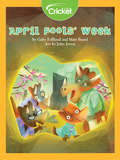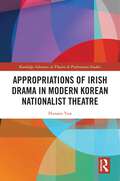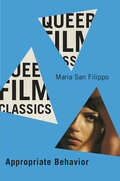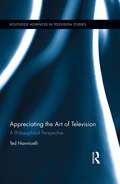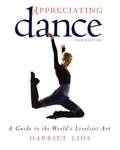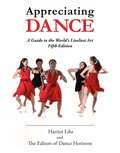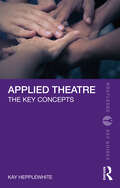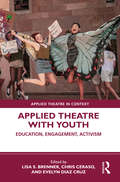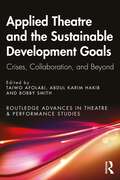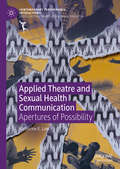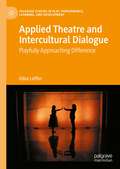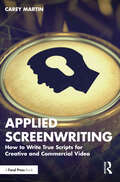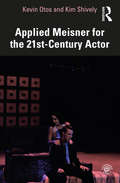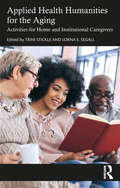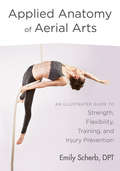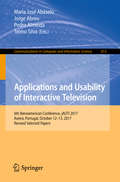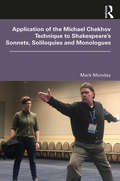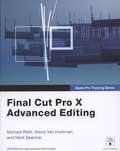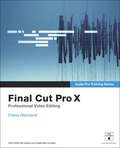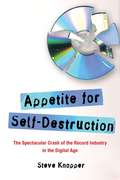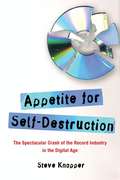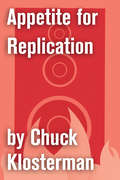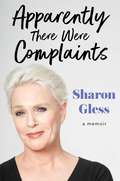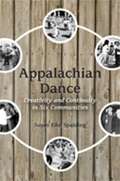- Table View
- List View
April Fools' Week
by Gaby FeBlandMeet the many generations of the great Dinostein Pranksters! In this family, April Fools' lasts a whole week. It's a tradition that dates back to the Jurassic Period. But little Joelle maybe the best prankster yet!
Appropriations of Irish Drama in Modern Korean Nationalist Theatre (Routledge Advances in Theatre & Performance Studies)
by Hunam YunThis book investigates the translation field as a hybrid space for the competing claims between the colonisers and the colonised. By tracing the process of the importation and appropriation of Irish drama in colonial Korea, this study shows how the intervention of the competing agents – both the colonisers and the colonised – formulates the strategies of representation or empowerment in the rival claims of the translation field. This exploration will be of great interest to students and scholars of theatre and performance studies, translation studies, and Asian studies.
Appropriate Behavior (Queer Film Classics)
by Maria San FilippoPremiering at Sundance in 2014, Desiree Akhavan’s acclaimed debut feature, Appropriate Behavior, introduced the indie film world to the deadpan, irreverent wit that had already won over fans of her trailblazing LGBTQ web series The Slope. The first volume in the Queer Film Classics series to spotlight a work by and about a bisexual woman of colour, this book explores Appropriate Behavior as an instant classic of US indie filmmaking in the 2010s, as a radical reappropriation of straight and gay film genres, as an artist’s coming-of-age story, and as a model for feminist-queer creative collaboration. Less than a decade old, Appropriate Behavior captures an urban queer community imperilled by gentrification and homonormativity and serves as exemplar of an innovative wave of independent cinema not yet subsumed by the streaming economy. Maria San Filippo explores how filmmaker and film render a singular voice and story that queers not only its celebrated romcom predecessors but also the gay coming-out film and the lesbian romance alike. The book concludes with an interview with Akhavan.San Filippo pays special tribute to Akhavan’s audacious sensibility and the “inbetweener” moxie that makes Appropriate Behavior an unparalleled portrayal of bisexuality.
Appreciating the Art of Television: A Philosophical Perspective (Routledge Advances in Television Studies)
by Ted NannicelliContemporary television has been marked by such exceptional programming that it is now common to hear claims that TV has finally become an art. In Appreciating the Art of Television, Nannicelli contends that televisual art is not a recent development, but has in fact existed for a long time. Yet despite the flourishing of two relevant academic subfields—the philosophy of film and television aesthetics—there is little scholarship on television, in general, as an art form. This book aims to provide scholars active in television aesthetics with a critical overview of the relevant philosophical literature, while also giving philosophers of film a particular account of the art of television that will hopefully spur further interest and debate. It offers the first sustained theoretical examination of what is involved in appreciating television as an art and how this bears on the practical business of television scholars, critics, students, and fans—namely the comprehension, interpretation, and evaluation of specific televisual artworks.
Appreciating Dance: A Guide to the World's Liveliest Art
by Harriet R. LihsWritten for the dance novice, this book is a concise, thorough, and accurate history of all forms of dance. It gives a brief biography of many of the notable dancers and choreographers who have contributed to each form of dance, and provides, in a nutshell, the information needed to expand the enjoyment of performance. It also details the history of dance from its earliest beginnings and covers the intersection of dance and religion, social dance, ballet, modern dance, tap, jazz, film dance, and contemporary dance.
Appreciating Dance: A Guide To The World's Liveliest Art
by Dance Horizons Editors Harriet LihsAppreciating Dance is a thorough and accurate history of various forms of dance, analyzing everything from social dance, and ballet to modern dance, tap, jazz, theatrical dance and contemporary dance. In it readers will find: a brief biography of notable dancers and choreographers; information needed to expand the enjoyment of performance; the intersection of dance and religion; the history of dance through the beginning of the 21st century; and budding dance trends. Every chapter in this fifth edition has been updated and revised with new information, including suggestions for YouTube viewing at the end of each chapter.
Applied Theatre: The Key Concepts (Routledge Key Guides)
by Kay HepplewhiteThis accessible book outlines the key ideas that define the global phenomenon of applied theatre, not only its theoretical underpinning, its origins and practice, but also providing eight real-life examples drawn from a diversity of forms and settings.The clearly arranged topic sections entitled When, What, Who, Why and Where emphasise the responsive nature of applied theatre, its social context and the importance of a beneficial outcome for participants, which can connect fields as disparate as health, criminal justice, education and migration. Labels and terms are explained, along with applied theatre’s core values, motivations and objectives, allowing the reader to build a coherent understanding of its distinguishing features.Applied Theatre: The Key Concepts is aimed at students, academics, artists and practitioners of applied theatre as well as those with an interest in this vital blend of social and creative practice.
Applied Theatre with Youth: Education, Engagement, Activism (Applied Theatre in Context)
by Lisa S. Brenner, Chris Ceraso, and Evelyn Diaz CruzApplied Theatre with Youth is a collection of essays that highlight the value and efficacy of applied theatre with young people in a broad range of settings, addressing challenges and offering concrete solutions. This book tackles the vital issues of our time—including, among others, racism, climate crisis, gun violence, immigration, and gender—fostering dialogue, promoting education, and inciting social change. The book is divided into thematic sections, each opening with an essay addressing a range of questions about the benefits, challenges, and learning opportunities of a particular type of applied theatre. These are followed by response essays from theatre practitioners, discussing how their own approach aligns with and/or diverges from that of the initial essay. Each section then ends with a moderated roundtable discussion between the essays’ authors, further exploring the themes, issues, and ideas that they have introduced. With its accessible format and clear language, Applied Theatre with Youth is a valuable resource for theatre practitioners and the growing number of theatre companies with education and community engagement programs. Additionally, it provides essential reading for teachers and students in a myriad of fields: education, theatre, civic engagement, criminal justice, sociology, women and gender studies, environmental studies, disability studies, ethnicity and race studies.
Applied Theatre and the Sustainable Development Goals: Crises, Collaboration, and Beyond (ISSN)
by Bobby Smith Taiwo Afolabi Abdul Karim HakibThis book is the first definitive publication to consider the intersections of applied theatre and the Sustainable Development Goals (SDGs) – a series of goals which have shaped development and social justice initiatives from 2015 to 2030.It brings together emerging and leading scholars and practitioners engaged in creative and community contexts globally. In so doing, the book offers critical insights to explore the convergences, complexities, and tensions of working within development frameworks, through theatre. Divided into three thematic areas, it maps out the ways in which applied theatre has related to the SDGs, examines issues with global collaborations, and, as 2030 approaches and the SDG era draws to a close, interrogates such practices, envisioning what the role of applied theatre might be in the post-SDG era. The book provokes reflection about this specific era of applied theatre and global development, as well as discussion regarding what comes next.This volume will be of importance to students, artists, scholars, practitioners, and policymakers working in applied theatre and the field of development.
Applied Theatre and Sexual Health Communication: Apertures of Possibility (Contemporary Performance InterActions)
by Katharine E. LowThis book analyses the partnership between applied theatre and sexual health communication in a theatre-making project in Nyanga, a township in South Africa. By examining the bridges and schisms between the two fields as they come together in the project, an alternative way of approaching sexual health communication is advocated. This alternative considers what it is that applied theatre does, and could become, in this context. Moments of value which lie around the margins of the practice emerge as opportunities that can be overlooked. These somewhat ephemeral, intangible moments, which appear on the edges, are described as ‘apertures of possibility’ and occur when one takes a step back and realises something unnoticed in the moment. This book offers an invitation to pause and notice the seemingly insignificant moments that often occurs tangentially to the practice. The book also calls for more outcry about sexual health and sexual violence, arguing for theatre-making as a route to multitudes of voices, nuanced understandings, and diverse spaces in which discussions of sexuality and sexual health are shared, felt, and experienced.
Applied Theatre and Intercultural Dialogue: Playfully Approaching Difference (Palgrave Studies In Play, Performance, Learning, and Development)
by Elliot LefflerThis book examines applied theatre projects that bring together diverse groups and foster intercultural dialogue. Based on five case studies and informed by play theory, it argues that the playful elements of theatre processes nurture a unique intimacy among diverse people. However, this playful quality can also dampen explicit conversations about participants’ cultural differences, and defer an interrogation of people’s own entrenchment in systemic power imbalances. As a result, addressing these differences and imbalances in applied theatre contexts may require particular strategies.
Applied Screenwriting: How to Write True Scripts for Creative and Commercial Video
by Carey MartinPutting a vision on the page for creative and commercial video is harder than it seems, but author Carey Martin explains how to bring these tools to bear in the “work for hire” environment. Whilst other texts focus on writing the next award winner, this can be out of reach both logistically and financially for many. Instead, readers will learn how to write what they want the eyes of the audience to see and the ears of the audience to hear, in such a way that the Producer and Director can read the creative blueprint and bring that vision to life. The text will walk readers through a focused and practical consideration of the camera, the edit, and the sound design, in addition to a straightforward application of basic story principles. By understanding writing for video as more than creating a recorded play, readers will become more effective screenwriters and, should they wish, Producers and Directors as well. This book is ideal for students of screenwriting and those writing scripts for message-driven video for corporate, nonprofit, and commercial production.
Applied Meisner for the 21st-Century Actor
by Kevin Otos Kim ShivelyApplied Meisner for the 21st-Century Actor develops Meisner’s core principles for the contemporary actor and presents a Meisner-based acting technique that empowers practitioners to take ownership of their own creative process. In this book, the authors present the best, most applicable foundational components of Meisner’s technique in a clear, pragmatic, and ethical manner, and advance Meisner's core principles with their own innovations. Drawing on the best practices of consent-based work, they outline a specific approach to creating clear boundaries for the actor and establishing an ethical acting studio. Filled with practical exercises, useful definitions and explanations of foundational principles, and helpful advice on how to recognize and overcome common acting traps and pitfalls, this book provides a replicable and flexible technique that puts the actor at the center of their training. Applied Meisner for the 21st-Century Actor offers actors and students of acting courses a workable technique that will foster growth and discovery throughout their career. The text also includes links to the companion website www.21CActor.com, where readers can engage with the material covered in the book and with Otos’ and Shively’s most up-to-date research, supplemental materials, and training opportunities.
Applied Health Humanities for the Aging: Activities for Home and Institutional Caregivers
by Trini Stickle Lorna E. SegallThis book provides a collection of interventions from researchers’ and clinicians’ health humanities experiences, and makes their methods available to home and institutional caregivers to aid interactions with the elderly, particularly persons diagnosed with dementia. As a revolutionary perspective connecting medical training and treatment with lessons from the humanities, medical humanities emphasizes the treatment and care of disease, the "science of the human," and offers an integrated approach to health professional education that include lessons from comparative religion, history, literature, philosophy, the visual and performing arts.Highlighting the needs of persons with dementia and their caregivers, this compilation shows how the arts can play a primary role in empowering families and communities to offer creative and meaningful care within their own homes and communities. Each chapter provides an overview of a specific creative application (reading and commonplacing; storytelling; intergenerational musical activities; Bingocize®; haiku making; and animatronic pet activities), the evidence-based support for its benefits, and clear and accessible instructions for the reader. These methods offer insightful approaches to care in which skills such as active listening can provide in-roads to patient experiences as well as an array of creative approaches to ameliorate the physical and mental consequences of isolation and loneliness that too often accompany aging and disease. This text will be of interest to healthcare workers and allied health professionals, healthcare administrators and family members.
Applied Anatomy of Aerial Arts: An Illustrated Guide to Strength, Flexibility, Training, and Injury Prevention
by Emily ScherbAn illustrated guide to anatomy and biomechanics for aerialists who want to optimize their performance and train safelySpecifically designed for aerialists—including those who do trapeze, silks, and other aerial arts— Applied Anatomy of Aerial Arts is an invaluable resource for those who want to optimize their performance and train safely. Using a biomechanical and movement-based approach, Emily Scherb—a physical therapist who specializes in the care, treatment, and education of circus performers—explains the anatomical rationale for progressions of learning and demonstrates simple movements to achieve the coordination, muscular control, strength, and fitness to hang with correct form, how to progress from hanging into a pull up, an inversion, and beyond with a strong center, precise muscle sequencing, and ease of movement. Aerialists will learn how bones, joints, muscles, and soft tissues allow for specific movements and gain an appreciation for concepts of proximal stability. This full-color illustrated guide lays a solid foundation for beginners and advanced students with a wealth of insights into their own performance as well as refreshers on fundamentals in warm ups and conditioning. It explains how to structure a training session, how to care for injuries, and best practices for basic self first aid.
Applications and Usability of Interactive Television: 6th Iberoamerican Conference, Jauti 2017, Aveiro, Portugal, October 12-13, 2017, Revised Selected Papers (Communications In Computer And Information Science #813)
by María José Abásolo Pedro Almeida Jorge Abreu Telmo SilvaThis book constitutes the refereed proceedings of the 6th Iberoamerican Conference on Applications and Usability of Interactive Television, jAUTI 2017, in Aveiro, Portugal, in October 2017. <P><P> The 11 full papers presented together with one invited talk paper were carefully reviewed and selected from numerous submissions. The papers are organized in topical sections on Design and Evaluation of IDTV Services and Content; IDTV Content Recommendation; Omnidirectional Video and Video Repositories; IDTV Interaction Techniques and Accessibility.
Application of the Michael Chekhov Technique to Shakespeare’s Sonnets, Soliloquies and Monologues
by Mark MondayApplication of the Michael Chekhov Technique to Shakespeare’s Sonnets, Soliloquies, and Monologues illustrates how to apply the Michael Chekhov Technique, through exercises and rehearsal techniques, to a wide range of Shakespeare’s works. The book begins with a comprehensive chapter on the definitions of the various aspects of the Technique, followed by five chapters covering Shakespeare’s sonnets, comedies, tragedies, histories, and romances. This volume offers a very specific path, via Michael Chekhov, on how to put theory into practice and bring one’s own artistic life into the work of Shakespeare. Offering a wide range of pieces that can be used as audition material, Application of the Michael Chekhov Technique to Shakespeare’s Sonnets, Soliloquies, and Monologues is an excellent resource for acting teachers, directors, and actors specializing in the work of William Shakespeare. The book also includes access to a video on Psychological Gesture to facilitate the application of this acting tool to Shakespeare’s scenes.
Apple Pro Training Series: Final Cut Pro X Advanced Editing
by Alexis Van Hurkman Mark Spencer Michael WohlIn this Apple-authorized guide, director and filmmaker Michael Wohl teaches the advanced skills that editing professionals need to know most. Using compelling professional footage, Wohl delivers a comprehensive course on the groundbreaking, entirely new Final Cut Pro X. · DVD-ROM includes lesson and media files · Focused lessons take you step-by-step through professional, real-world projects · Accessible writing style puts an expert instructor at your side · Ample illustrations and keyboard shortcuts help you master techniques fast · Lesson goals and time estimates help you plan your time · Chapter review questions summarize what you've learned and prepare you for the Apple Certified Pro Exam
Apple Pro Training Series: Final Cut Pro X
by Diana WeynandCompletely revised for Final Cut Pro X and featuring compelling new footage, this best-selling, Apple-certified guide provides a strong foundation in all aspects of video editing. Renowned author Diana Weynand starts with basic video editing techniques and takes readers all the way through Final Cut Pro's powerful features. Each chapter presents a complete lesson in an aspect of video editing and finishing, using professional broadcast footage. The book covers Final Cut Pro's exciting new features, including a completely redesigned interface, people detection, and Magnetic Timeline. · DVD-ROM includes lesson and media files for over 40 hours of training · Focused lessons take you step-by-step through professional, real-world projects · Accessible writing style puts an expert instructor at your side · Ample illustrations and keyboard shortcuts help you master techniques fast · Lesson goals and time estimates help you plan your time · Chapter review questions summarize what you've learned and prepare you for the Apple Certified Pro Exam
Appetites and Anxieties: Food, Film, and the Politics of Representation
by Cynthia Baron Diane Carson Mark BernardCinema is a mosaic of memorable food scenes. Detectives drink alone. Gangsters talk with their mouths full. Families around the world argue at dinner. Food documentaries challenge popular consumption-centered visions. In Appetites and Anxieties: Food, Film, and the Politics of Representation, authors Cynthia Baron, Diane Carson, and Mark Bernard use a foodways paradigm, drawn from the fields of folklore and cultural anthropology, to illuminate film's cultural and material politics. In looking at how films do and do not represent food procurement, preparation, presentation, consumption, clean-up, and disposal, the authors bring the pleasures, dangers, and implications of consumption to center stage. In nine chapters, Baron, Carson, and Bernard consider food in fiction films and documentaries-from both American and international cinema. The first chapter examines film practice from the foodways perspective, supplying a foundation for the collection of case studies that follow. Chapter 2 takes a political economy approach as it examines the food industry and the film industry's policies that determine representations of food in film. In chapter 3, the authors explore food and food interactions as a means for creating community in Bagdad Café, while in chapter 4 they take a close look at 301/302, in which food is used to mount social critique. Chapter 5 focuses on cannibal films, showing how the foodways paradigm unlocks the implications of films that dramatize one of society's greatest food taboos. In chapter 6, the authors demonstrate ways that insights generated by the foodways lens can enrich genre and auteur studies. Chapter 7 considers documentaries about food and water resources, while chapter 8 examines food documentaries that slip through the cracks of film censorship by going into exhibition without an MPAA rating. Finally, in chapter 9, the authors study films from several national cinemas to explore the intersection of food, gender, and ethnicity. Four appendices provide insights from a food stylist, a selected filmography of fiction films and a filmography of documentaries that feature foodways components, and a list of selected works in food and cultural studies.
Appetite for Self-Destruction: The Spectacular Crash of the Record Industry in the Digital Age
by Steve KnopperFor the first time, Appetite for Self-Destruction recounts the epic story of the precipitous rise and fall of the recording industry over the past three decades, when the incredible success of the CD turned the music business into one of the most glamorous, high-profile industries in the world -- and the advent of file sharing brought it to its knees. In a comprehensive, fast-paced account full of larger-than-life personalities, Rolling Stone contributing editor Steve Knopper shows that, after the incredible wealth and excess of the '80s and '90s, Sony, Warner, and the other big players brought about their own downfall through years of denial and bad decisions in the face of dramatic advances in technology. Big Music has been asleep at the wheel ever since Napster revolutionized the way music was distributed in the 1990s. Now, because powerful people like Doug Morris and Tommy Mottola failed to recognize the incredible potential of file-sharing technology, the labels are in danger of becoming completely obsolete. Knopper, who has been writing about the industry for more than ten years, has unparalleled access to those intimately involved in the music world's highs and lows. Based on interviews with more than two hundred music industry sources -- from Warner Music chairman Edgar Bronfman Jr. to renegade Napster creator Shawn Fanning -- Knopper is the first to offer such a detailed and sweeping contemporary history of the industry's wild ride through the past three decades. From the birth of the compact disc, through the explosion of CD sales in the '80s and '90s, the emergence of Napster, and the secret talks that led to iTunes, to the current collapse of the industry as CD sales plummet, Knopper takes us inside the boardrooms, recording studios, private estates, garage computer labs, company jets, corporate infighting, and secret deals of the big names and behind-the-scenes players who made it all happen. With unforgettable portraits of the music world's mighty and formerly mighty; detailed accounts of both brilliant and stupid ideas brought to fruition or left on the cutting-room floor; the dish on backroom schemes, negotiations, and brawls; and several previously unreported stories, Appetite for Self-Destruction is a riveting, informative, and highly entertaining read. It offers a broad perspective on the current state of Big Music, how it got into these dire straits, and where it's going from here -- and a cautionary tale for the digital age.
Appetite for Self-Destruction: The Spectacular Crash of the Record Industry in the Digital Age
by Steve KnopperFor the first time, Appetite for Self-Destruction recounts the epic story of the precipitous rise and fall of the recording industry over the past three decades, when the incredible success of the CD turned the music business into one of the most glamorous, high-profile industries in the world -- and the advent of file sharing brought it to its knees. In a comprehensive, fast-paced account full of larger-than-life personalities, Rolling Stone contributing editor Steve Knopper shows that, after the incredible wealth and excess of the '80s and '90s, Sony, Warner, and the other big players brought about their own downfall through years of denial and bad decisions in the face of dramatic advances in technology.
Appetite for Replication
by Chuck KlostermanOriginally collected in Sex, Drugs, and Cocoa Puffs and now available both as a stand-alone essay and in the ebook collection Chuck Klosterman on Rock, this essay is about a Guns N' Roses tribute band.
Apparently There Were Complaints: A Memoir
by Sharon GlessEmmy Award–winning actress Sharon Gless tells all in this laugh-out-loud, juicy, &“unforgettably memorable&” (Lily Tomlin) memoir about her five decades in Hollywood, where she took on some of the most groundbreaking roles of her time.Anyone who has seen Sharon Gless act in Cagney & Lacey, Queer as Folk, Burn Notice, and countless other shows and movies, knows that she&’s someone who gives every role her all. She holds nothing back in Apparently There Were Complaints, a hilarious, deeply personal memoir that spills all about Gless&’s five decades in Hollywood. A fifth-generation Californian, Sharon Gless knew from a young age that she wanted to be an actress. After some rocky teenage years that included Sharon&’s parents&’ divorce and some minor (and not-so-minor) rebellion, Gless landed a coveted spot as an exclusive contract player for Universal Studios. In 1982, she stepped into the role of New York Police Detective Christine Cagney for the series Cagney & Lacey, which eventually reached an audience of 30 million weekly viewers and garnered Gless with two Emmy Awards. The show made history as the first hour-long drama to feature two women in the leading roles. Gless continued to make history long after Cagney & Lacey was over. In 2000, she took on the role of outrageous Debbie Novotny in Queer as Folk. Her portrayal of a devoted mother to a gay son and confidant to his gay friends touched countless hearts and changed the definition of family for millions of viewers. Apparently There Were Complaints delves into Gless&’s remarkable career and explores Gless&’s complicated family, her struggles with alcoholism, and her fear of romantic commitment as well as her encounters with some of Hollywood&’s biggest names. Brutally honest and incredibly relatable, Gless puts it all out on the page in the same way she has lived—never with moderation.
Appalachian Dance: Creativity and Continuity in Six Communities
by Susan Eike SpaldingIn Appalachian Dance, Susan Eike Spalding employs twenty-five years' worth of rich interviews with black and white Virginians, Tennesseeans, and Kentuckians to explore the evolution and social uses of dance practices in each region. Spalding analyzes how issues as disparate as industrialization around coal, race relations, and the 1970s folk revival profoundly influenced freestyle clogging and other dance forms. She reveals how African Americans and Native Americans, as well as European immigrants drawn to the timber mills and coal fields, added to local dance vocabularies. By placing each community in its sociopolitical and economic context, Spalding explores how the formal and stylistic nuances found in Appalachian dance reflect the beliefs, shared understandings, and experiences of the community at large.
